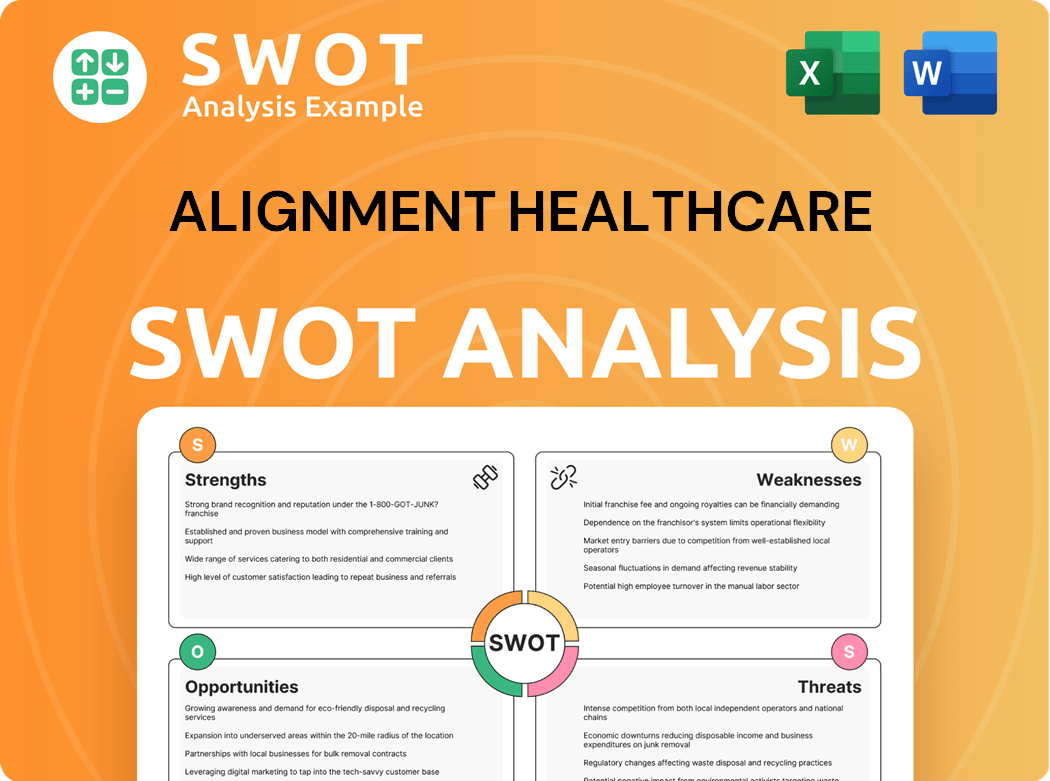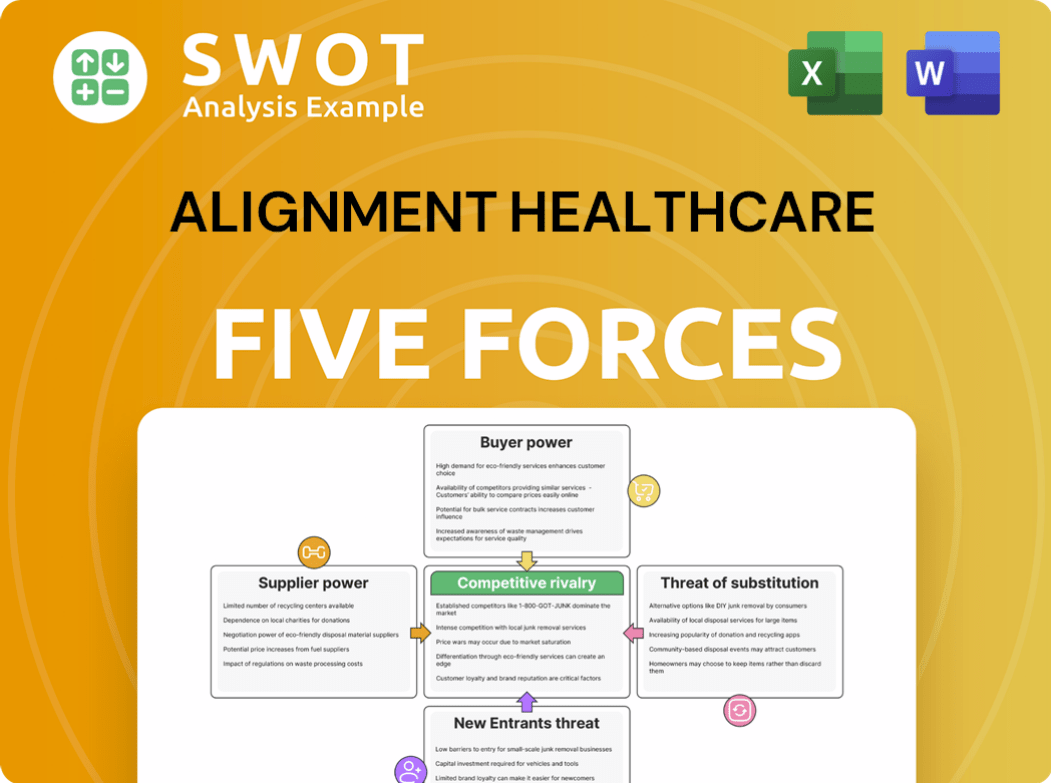Alignment Healthcare Bundle
Who Really Controls Alignment Healthcare?
Understanding the ownership structure of a company is crucial for any investor or stakeholder. Alignment Healthcare, a key player in the Medicare Advantage market, underwent a significant transformation with its IPO in 2021. This shift from private equity to public ownership has reshaped its strategic focus and accountability.

This analysis will explore the evolution of Alignment Healthcare SWOT Analysis, examining key players from its founding to its current status as a publicly traded entity. We'll uncover who owns Alignment Healthcare, delving into the stakes held by founders, institutional investors, and the public, providing insights into the company's strategic direction and future prospects. Furthermore, we will also examine the Alignment Healthcare SWOT Analysis to understand the company's strengths, weaknesses, opportunities, and threats, offering a comprehensive view of its position in the market. Knowing Who owns Alignment Healthcare is essential for anyone following Alignment Healthcare stock.
Who Founded Alignment Healthcare?
Understanding the foundation of any company is crucial, and for Alignment Healthcare, it starts with its origins. The company's ownership structure and early financial backing provide insights into its strategic direction and growth trajectory. Examining the founders and initial investors of Alignment Healthcare reveals key players and their influence on the company's development.
The evolution of Alignment Healthcare from a limited liability company to a publicly traded corporation is a significant aspect of its ownership history. This transition involved legal restructuring, impacting the distribution of shares and the influence of early investors. The conversion process and subsequent mergers shaped the ownership landscape, setting the stage for its future.
The early investment rounds and the involvement of private equity firms played a pivotal role in Alignment Healthcare's growth. These investments not only provided capital but also brought in strategic expertise and guidance. The backing from firms like General Atlantic and Warburg Pincus highlights the confidence in the company's business model and its potential within the healthcare sector.
Alignment Healthcare was established in 2013 by John Kao. Initially, it operated as Alignment Healthcare Holdings, LLC, a Delaware limited liability company.
Prior to its IPO, Alignment Healthcare Holdings, LLC converted into Alignment Healthcare, Inc., a Delaware corporation. This change was a key step before going public.
Alignment Healthcare Partners, LP, the sole unitholder of the LLC, became the sole holder of the corporation's common stock. This reflects the shift in ownership structure.
Alignment Partners merged into Alignment Healthcare, Inc., with partners receiving common stock in exchange for their units. This consolidated ownership.
General Atlantic invested $125 million in April 2014. Warburg Pincus invested $115 million in March 2017, showing strong backing from private equity.
At the IPO in March 2021, John Kao, as founder and CEO, held 1.5% of the shares. This stake was valued at over $60 million, highlighting his significant investment.
The founder, John Kao, initially established the company and played a crucial role in securing early investments. The conversion to a corporation and the merger of Alignment Partners streamlined the ownership structure. Private equity firms like General Atlantic and Warburg Pincus provided significant financial support, reflecting confidence in the company's model. At the IPO, John Kao, as the largest individual investor, demonstrated his commitment.
- John Kao, founder and CEO, held a significant stake, underscoring his commitment.
- Early investments from General Atlantic and Warburg Pincus fueled growth.
- The company's evolution from an LLC to a corporation was a strategic move.
- These early financial decisions shaped Alignment Healthcare's trajectory.
Alignment Healthcare SWOT Analysis
- Complete SWOT Breakdown
- Fully Customizable
- Editable in Excel & Word
- Professional Formatting
- Investor-Ready Format

How Has Alignment Healthcare’s Ownership Changed Over Time?
The journey of Alignment Healthcare from a private entity to a publicly traded company marked a significant shift in its ownership structure. This transition occurred on March 26, 2021, with its Initial Public Offering (IPO). The IPO involved the sale of 27.2 million shares at $18.00 each, which successfully raised roughly $489.6 million. Following the IPO, the company's market capitalization reached $4.3 billion, indicating a strong initial investor confidence.
The ownership landscape of Alignment Healthcare has been shaped by key investment rounds and strategic decisions. Before going public, a Series C funding round in March 2020, which raised $135 million, saw the addition of Fidelity Management & Research Company and Durable Capital Partners L.P. as notable investors. This round brought the total funding to $375 million, fueling the company's growth trajectory.
| Event | Date | Impact |
|---|---|---|
| Series C Funding Round | March 2020 | Raised $135 million, total funding reached $375 million |
| Initial Public Offering (IPO) | March 26, 2021 | Raised approximately $489.6 million, market capitalization reached $4.3 billion |
| Institutional Investment | Ongoing | Significant institutional ownership, driving strategic alignment and expansion |
As of May 2025, institutional investors hold a significant majority of Alignment Healthcare's shares, ranging from approximately 63% to 84.93%. General Atlantic, a healthcare-focused private equity firm, remains a major stakeholder, owning roughly 22% to 22.95% of the shares. Other significant institutional shareholders as of March 31, 2025, include Fmr Llc (7.20% as of May 12, 2025), Vanguard Group Inc. (5.798%), BlackRock, Inc. (5.147%), T. Rowe Price Investment Management, Inc., and Wellington Management Group Llp. These major shareholders, along with the company's leadership team, play a crucial role in shaping the company's strategic direction and financial performance.
The ownership of Alignment Healthcare has evolved significantly, transitioning from private to public with a strong institutional investor base.
- Institutional investors hold a substantial portion of the shares, indicating confidence in the company's growth potential.
- General Atlantic remains a key stakeholder, reflecting continued private equity involvement.
- The IPO in 2021 was a pivotal moment, raising significant capital and increasing market visibility.
- Strategic investments and funding rounds have fueled Alignment Healthcare's expansion and technological advancements.
Alignment Healthcare PESTLE Analysis
- Covers All 6 PESTLE Categories
- No Research Needed – Save Hours of Work
- Built by Experts, Trusted by Consultants
- Instant Download, Ready to Use
- 100% Editable, Fully Customizable

Who Sits on Alignment Healthcare’s Board?
The Board of Directors at Alignment Healthcare is responsible for guiding the company's strategic direction and overseeing its operations. Information from SEC filings, including those from 2022, indicates that the company's primary shareholders, often private equity firms, nominate directors to the Board. This suggests that major investors, such as General Atlantic and Warburg Pincus, have board representation, which allows them to influence strategic decisions. Understanding the composition of the board is key for those interested in the competitive landscape of Alignment Healthcare.
As of May 2025, the leadership team includes John Kao, the founder, serving as President, CEO, and Director. Dawn Maroney, promoted to President in January 2025, oversees day-to-day operations and reports to John Kao. Other key insiders with share ownership include Joseph Konowiecki, Robert Thomas Freeman, Dr. Hyong Kim, Christopher J. Joyce, Jody L. Bilney, Margaret M. McCarthy, Yon Yoon Jorden, Dr. Jacqueline B. Kosecoff, and David C. Hodgson. These individuals play a significant role in the company's governance and strategic decisions.
| Board Member | Title | Key Role |
|---|---|---|
| John Kao | President, CEO, and Director | Founder, leads overall strategy and operations |
| Dawn Maroney | President | Oversees day-to-day operations |
| Joseph Konowiecki | Director | Significant shareholder |
Alignment Healthcare's voting structure generally operates on a one-share-one-vote basis for its common stock. Shares held by executive officers, directors, and holders of 5% or more of the outstanding common stock may be deemed affiliates. The board's focus includes monitoring market conditions and prioritizing employee and member care. The collective experience of the board members in clinical, operational, technological, financial, and policy areas is crucial for effective oversight. This structure helps determine the Who owns Alignment Healthcare
and the influence of various stakeholders on the company's direction. The company's financial reports provide detailed insights into the Alignment Healthcare ownership
structure.
The Board of Directors at Alignment Healthcare includes key executives and representatives from major shareholders.
- John Kao, the founder, leads as CEO and President.
- Major shareholders, such as General Atlantic and Warburg Pincus, likely have board representation.
- Voting operates on a one-share-one-vote basis.
- The board focuses on market conditions and employee/member care.
Alignment Healthcare Business Model Canvas
- Complete 9-Block Business Model Canvas
- Effortlessly Communicate Your Business Strategy
- Investor-Ready BMC Format
- 100% Editable and Customizable
- Clear and Structured Layout

What Recent Changes Have Shaped Alignment Healthcare’s Ownership Landscape?
In the past few years, Alignment Healthcare has experienced considerable growth, alongside shifts in its ownership structure. The company's IPO in March 2021 raised roughly $490 million. As of May 2025, institutional investors held a significant portion, between 63% and 89.13%, of Alignment Healthcare shares. Key institutional holders include General Atlantic, Fmr Llc, Vanguard Group Inc., and BlackRock, Inc. The institutional ownership remained largely unchanged at 89.13% in May 2025, while mutual fund holdings were at 39.99%.
There have been notable insider transactions within Alignment Healthcare. Top executives, including CEO John Kao and President Dawn Maroney, sold shares in late 2024 and early 2025. For instance, John Kao sold 90,000 shares in February 2025 for approximately $1.28 million, but still retains a substantial stake of over 2.7 million shares. These transactions often relate to compensation packages, encompassing equity grants and vesting schedules. For further insights into the company's performance, you can refer to a detailed Alignment Healthcare company profile.
| Metric | Q1 2025 | 2025 Projection |
|---|---|---|
| Revenue | $926.9 million | $3.77–3.82 billion |
| Medicare Advantage Membership | 217,500 members | 228,000–233,000 members |
| Net Loss | $9.4 million | N/A |
| Adjusted EBITDA | $20.2 million | N/A |
Alignment Healthcare's Q1 2025 revenue surged 47.5% year-over-year to $926.9 million, and Medicare Advantage membership grew 31.7% to 217,500 members. The company projects year-end membership of 228,000–233,000 and revenue of $3.77–3.82 billion for 2025. Despite a net loss of $9.4 million in Q1 2025, positive adjusted EBITDA of $20.2 million indicates a move towards sustainable profitability. The company anticipates an approximate 8% weighted average rate increase in 2026.
Institutional investors hold a substantial portion of ALHC shares, indicating confidence in the company's long-term potential. This trend aligns with the broader increase in institutional ownership within the healthcare sector.
Executive share sales have occurred, often related to compensation structures. Despite these sales, key executives still retain significant stakes in the company, reflecting ongoing commitment.
Alignment Healthcare demonstrated strong operational performance, with significant revenue growth and membership expansion. The company is working towards sustainable profitability, as indicated by positive adjusted EBITDA.
The company's focus on technology-driven care and strategic investments continues to fuel growth. Projections for 2025 indicate further expansion in membership and revenue, with an anticipated rate increase in 2026.
Alignment Healthcare Porter's Five Forces Analysis
- Covers All 5 Competitive Forces in Detail
- Structured for Consultants, Students, and Founders
- 100% Editable in Microsoft Word & Excel
- Instant Digital Download – Use Immediately
- Compatible with Mac & PC – Fully Unlocked

Related Blogs
- What are Mission Vision & Core Values of Alignment Healthcare Company?
- What is Competitive Landscape of Alignment Healthcare Company?
- What is Growth Strategy and Future Prospects of Alignment Healthcare Company?
- How Does Alignment Healthcare Company Work?
- What is Sales and Marketing Strategy of Alignment Healthcare Company?
- What is Brief History of Alignment Healthcare Company?
- What is Customer Demographics and Target Market of Alignment Healthcare Company?
Disclaimer
All information, articles, and product details provided on this website are for general informational and educational purposes only. We do not claim any ownership over, nor do we intend to infringe upon, any trademarks, copyrights, logos, brand names, or other intellectual property mentioned or depicted on this site. Such intellectual property remains the property of its respective owners, and any references here are made solely for identification or informational purposes, without implying any affiliation, endorsement, or partnership.
We make no representations or warranties, express or implied, regarding the accuracy, completeness, or suitability of any content or products presented. Nothing on this website should be construed as legal, tax, investment, financial, medical, or other professional advice. In addition, no part of this site—including articles or product references—constitutes a solicitation, recommendation, endorsement, advertisement, or offer to buy or sell any securities, franchises, or other financial instruments, particularly in jurisdictions where such activity would be unlawful.
All content is of a general nature and may not address the specific circumstances of any individual or entity. It is not a substitute for professional advice or services. Any actions you take based on the information provided here are strictly at your own risk. You accept full responsibility for any decisions or outcomes arising from your use of this website and agree to release us from any liability in connection with your use of, or reliance upon, the content or products found herein.